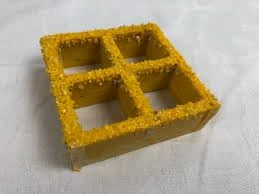loading...
- No. 9, Xingyuan South Street, Dongwaihuan Road, Zaoqiang County, Hengshui, Hebei, China
- admin@zjcomposites.com
- +86 15097380338
- Welcome to visit our website!
FRP Sectional Water Tank for Reliable Water Storage Solutions and Applications
Understanding FRP Sectional Water Tanks Features and Benefits
In today's rapidly evolving world, the importance of efficient water storage solutions cannot be overstated. One such innovative solution is the FRP (Fiberglass Reinforced Plastic) sectional water tank. Particularly popular in various industries, FRP sectional tanks provide numerous advantages over traditional water storage options, making them an ideal choice for many applications.
What are FRP Sectional Water Tanks?
FRP sectional water tanks are manufactured from fiberglass reinforced plastic, a composite material that combines high strength with lightweight properties. These tanks are constructed in modular sections, which can be assembled on-site to create a tank of any required size. This customizable nature makes them highly versatile, able to meet a range of storage needs, from residential use to large industrial applications.
Key Features of FRP Sectional Water Tanks
1. Durability and Longevity One of the standout features of FRP sectional water tanks is their exceptional durability. Unlike conventional materials such as steel or concrete, fiberglass is resistant to corrosion, rust, and the detrimental effects of UV radiation. This resistance translates to a longer lifespan, reducing the need for frequent replacements or repairs.
2. Lightweight and Easy to Install Compared to traditional water tanks, FRP tanks are significantly lighter, making transportation and installation much easier. The modular design allows for quick assembly, often requiring fewer resources and less labor. This is particularly beneficial for sites with limited accessibility or where heavy machinery cannot be used.
3. High Strength-to-Weight Ratio The composite nature of fiberglass gives FRP tanks a remarkable strength-to-weight ratio. This means that despite their lightweight construction, they can handle substantial pressure and temperature variations, making them suitable for a wide range of environments.
4. Thermal Insulation FRP materials provide excellent thermal insulation, helping to maintain the temperature of the stored water. This characteristic is crucial for applications where water quality and temperature are significant factors, such as in food processing or pharmaceuticals.
frp sectional water tank

5. Modularity The sectional design of FRP tanks means they can be easily expanded or reconfigured based on changing needs. Whether an organization requires additional storage space or wishes to change the tank's layout, modifications can be made without extensive construction work.
6. Hygienic and Safe FRP tanks are non-toxic and do not leach harmful substances into the stored water, ensuring safe drinking water storage. They are also easy to clean and maintain, supporting better hygiene standards.
Applications of FRP Sectional Water Tanks
The applications for FRP sectional water tanks are vast. In industrial settings, they are used for water treatment, fire fighting systems, and raw water storage. In residential and commercial sectors, they serve as reliable solutions for drinking water, irrigation, and other fluid storage needs. Furthermore, their resistance to environmental factors makes them suitable for various climates, including extreme temperatures and humidity levels.
Environmental Considerations
In addition to their practical benefits, FRP sectional water tanks are also more environmentally friendly compared to traditional options. Their longevity reduces the frequency of replacements, thus minimizing waste. Moreover, owing to their lightweight nature, less energy is consumed during transportation, contributing to lower carbon footprints.
Conclusion
In summary, FRP sectional water tanks offer a modern, efficient solution for a wide range of water storage needs. Their combination of durability, flexibility, and safety features make them a preferred choice across various sectors. As industries continue to seek sustainable and efficient storage solutions, FRP sectional water tanks are poised to become even more integral to water management systems worldwide. Embracing this innovative technology not only ensures effective water storage but also contributes to a greener and more sustainable future.
-
Transform Your Spaces with FRP Grating SolutionsNewsNov.04,2024
-
The Versatility and Strength of FRP RodsNewsNov.04,2024
-
The Excellence of Fiberglass Water TanksNewsNov.04,2024
-
The Benefits of FRP Grating for Your ProjectsNewsNov.04,2024
-
Elevate Your Efficiency with FRP Pressure VesselsNewsNov.04,2024
-
Welcome to the World of FRP Pressure VesselsNewsOct.12,2024
-
Unveiling the Future of Filtration: Why FRP Filter Vessels are a Game ChangerNewsOct.12,2024
